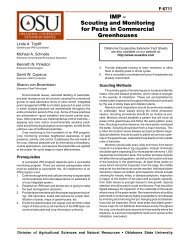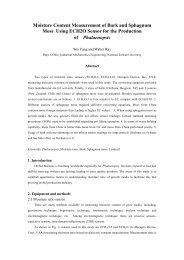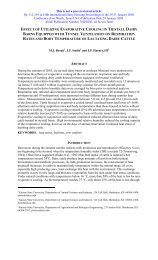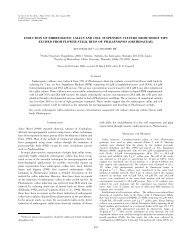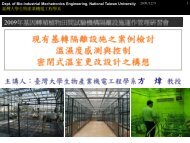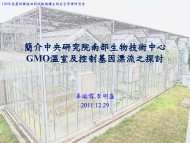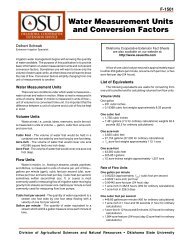The Orchid Grower
The Orchid Grower
The Orchid Grower
You also want an ePaper? Increase the reach of your titles
YUMPU automatically turns print PDFs into web optimized ePapers that Google loves.
PRODUCTION<br />
ORCHIDS<br />
<strong>The</strong> <strong>Orchid</strong><br />
<strong>Grower</strong><br />
<strong>Orchid</strong>s are the second hottest potted flowering plant in the United States. Find<br />
out how to cash in on the exotic crop everyone wants in this four-part series.<br />
by ERIK RUNKLE, YIN-TUNG WANG,<br />
MATTHEW BLANCHARD and<br />
ROBERTO LOPEZ<br />
Three flowering orchid plants are put<br />
together in a decorative container in<br />
Japan. Flower spikes are wired to create<br />
a very showy floral display.<br />
ORCHIDS, orchids, they<br />
seem to be popping up<br />
everywhere. <strong>The</strong>y’re on<br />
television, in home and<br />
garden magazines and at your local<br />
mass merchandiser. And they’re not<br />
just for the rich and famous anymore.<br />
<strong>The</strong>y are now one of the hottest potted<br />
flowering plants to purchase.<br />
Why? <strong>The</strong>re are many positive attributes<br />
to potted flowering orchids. For<br />
one, they are tropical plants that are<br />
still considered unique, stylish and exotic.<br />
Phalaenopsis, or the moth orchid,<br />
has flowers that can last for months,<br />
and they are relatively easy to care for<br />
and reflower in the home. And, because<br />
commercial production has become<br />
more efficient, costs have gone<br />
down, making them an affordable alternative<br />
to other flowering crops.<br />
Phalaenopsis orchids are nothing<br />
new – they have been grown and enjoyed<br />
for decades. Once prized primarily<br />
by orchid hobbyists, they were<br />
expensive to purchase and not usually<br />
available outside of specialty shops or<br />
orchid venues. Over the past 20 years,<br />
production information generated by<br />
growers and researchers has advanced<br />
to the point that phalaenopsis can be<br />
scheduled in flower en masse for specific<br />
markets. In addition, hybridization<br />
by breeders has led to orchids<br />
with more desirable traits.<br />
This article is the first of a four-part<br />
series that focuses on commercial production<br />
of flowering phalaenopsis orchids.<br />
Unlike some production guides,<br />
this series of articles contains researchbased<br />
information, much of which has<br />
been generated at Michigan State<br />
University and Texas A&M University.<br />
<strong>The</strong>re are still many “wives tales” on<br />
how to grow orchids, but this is our<br />
attempt to set the record straight.<br />
This article provides introductory<br />
information on phalaenopsis and options<br />
for starting material and propagation.<br />
<strong>The</strong> second and third articles<br />
will focus on cultural and environmental<br />
methods for vegetative growth<br />
and flowering of phalaenopsis plants.<br />
<strong>The</strong> series will culminate with an example<br />
of a detailed phalaenopsis production<br />
schedule.<br />
A Hot Crop<br />
It might surprise you that potted<br />
flowering orchids are the second-most<br />
valuable potted flowering plant produced<br />
in the United States. In 2004, the<br />
wholesale value sold in the United<br />
States was estimated at $127 million by<br />
the USDA. About 80 percent of this<br />
value was for phalaenopsis. California,<br />
Florida and Hawaii produce more than<br />
85 percent of all the orchids sold in the<br />
United States, with wholesale values<br />
reported at $48 million, $40 million and<br />
$17 million, respectively.<br />
Phalaenopsis dominate the orchid<br />
market because of their long-lasting<br />
flowers, wide range of flower colors,<br />
ease of care and ease to schedule into<br />
flower. Additionally, flowering phalaenopsis<br />
command a considerably<br />
higher wholesale price when compared<br />
to more traditional potted plants.<br />
Phalaenopsis are not just popular in<br />
North America; for the past few years,<br />
they have been the most valuable potted<br />
plants sold at the Dutch flower auctions.<br />
<strong>The</strong>y are also highly prized gifts<br />
throughout Asia, especially in Japan.<br />
An International Marketplace<br />
Phalaenopsis are produced throughout<br />
the world, but most notably in<br />
Germany, Japan, the Netherlands,<br />
Taiwan, Thailand and the United<br />
States. Outside of the United States,<br />
many young plants are propagated<br />
and grown in the Netherlands, Taiwan<br />
and Thailand.<br />
Similar to poinsettia, greenhouse<br />
growers obtain orchid genetics from<br />
companies that have been intensively<br />
breeding for desirable flowering and<br />
plant characteristics. Many companies<br />
are breeding for specific flower colors<br />
64 July 2005 • Greenhouse <strong>Grower</strong>
PRODUCTION<br />
ORCHIDS<br />
and color patterns, multi- and singlebranched<br />
flower spikes, and most recently,<br />
fragrance. Some of the larger<br />
breeding companies and young plant<br />
producers are Altria, Floricultura,<br />
Formosa, I-Shin, Taiwan Sugar,<br />
Twyford and Yupin. <strong>Grower</strong>s should<br />
consider evaluating the genetics from<br />
several sources to determine how cultivars<br />
perform and which best suit<br />
their market.<br />
Left: Phalaenopsis propagated by tissue culture in Thailand. Plants are grown in<br />
flasks for 10 to 12 months before first transplanting.<br />
Right: After removal from the flask, plants are grown at 80°F to 90°F (27°C to<br />
32°C) in either flats or small containers.<br />
Plant Material<br />
<strong>The</strong>re are literally hundreds, if not<br />
thousands, of phalaenopsis hybrids<br />
and clones available for purchase.<br />
Breeding continues at a rapid pace,<br />
and a popular cultivar available<br />
today may not be commercially available<br />
in just a few years. Flower colors<br />
include white, yellow, green, apricot,<br />
pink, magenta and dark maroon.<br />
Flowers can be of one color or two,<br />
with different colored centers or margins<br />
or with various patterns including<br />
spots and stripes. <strong>The</strong> newest harlequin<br />
flowers are white with irregular<br />
purple blotches.<br />
Although some phalaenopsis are<br />
produced from seed, an increasing<br />
majority are cloned from a growing<br />
point, or meristem. <strong>The</strong>se plants are<br />
called “mericlones.” <strong>The</strong> cloning<br />
process reduces variability from plant<br />
to plant, so populations have similar<br />
growth and flowering characteristics.<br />
Phalaenopsis are propagated in laboratories<br />
by tissue culture, and are<br />
usually grown in flasks for 10 to 12<br />
months under low light (maximum of<br />
50 to 100 footcandles, or 10 to 20<br />
µmol•m -2 •s -1 ) (Figure 3). When young<br />
plants reach a leaf span of about 2<br />
inches (5 cm), they are taken out of<br />
the flasks and transplanted into flats<br />
or small pots containing a fine barkor<br />
sphagnum-based media.<br />
Once plants are removed from<br />
their flasks, they are grown for 20 to<br />
25 weeks at 80°F to 90°F, (27°C to<br />
32°C) until they are ready for transplanting<br />
into a larger container.<br />
Vegetative growth is promoted by<br />
For Details Circle No. 53 on Postcard or at www.greenhousegrower.com<br />
65 July 2005 • Greenhouse <strong>Grower</strong>
PRODUCTION<br />
ORCHIDS<br />
high temperature (80°F to 90°F), and<br />
thus most plants are grown until maturity<br />
in tropical and subtropical environments.<br />
Plant size, or maturity, is<br />
often expressed as the leaf span from<br />
one end of a leaf to the opposite leaf<br />
end. As young plants develop, each<br />
new leaf becomes larger than the previous<br />
one. After transplanting to a<br />
larger container, plants may need another<br />
20 to 25 weeks before being<br />
capable of spiking.<br />
Subsequent growth continues at<br />
these high temperatures to inhibit flowering<br />
and promote rapid leaf development.<br />
Plants must be large enough, or<br />
mature, before they are capable of flowering.<br />
Although differences exist<br />
among cultivars, most cultivars won’t<br />
flower uniformly until the leaf span of a<br />
population averages at least 10 inches<br />
(25 cm) wide. However, breeders are<br />
developing more hybrids and clones<br />
that mature when reaching a smaller<br />
(15 cm) leaf span.<br />
<strong>The</strong>re are several different sizes of<br />
plant material that can be purchased,<br />
including plants in flasks, immature<br />
plants that are not of flowering size<br />
and large, mature plants without or<br />
with flower spikes. <strong>The</strong> larger the<br />
plants are, the higher the price.<br />
Phalaenopsis plants growing in media<br />
can be purchased from companies<br />
within the United States.<br />
Alternatively, plants can be imported<br />
as bare-root, often from the<br />
Netherlands, Taiwan and Thailand.<br />
<strong>Grower</strong>s now can import phalaenopsis<br />
in an approved growing media<br />
from Taiwan, made possible from a recent<br />
ruling by USDA’s Animal and<br />
Plant Health Inspection Service<br />
(APHIS). When purchasing phalaenopsis<br />
from offshore sources, ask<br />
for the C&F price, which includes the<br />
cost for the plants and freight.<br />
Measuring Up<br />
<strong>The</strong> size of plant material purchased<br />
determines if and how long plants<br />
need to be grown at high temperature<br />
Approximately 20 to 25 weeks after<br />
the first transplant, phalaenopsis are<br />
transplanted into a larger pot [here, in<br />
a 4-inch (10 cm) pot] for continued<br />
vegetative growth, or are sold as bareroot<br />
young plants.<br />
For Details Circle No. 17 on Postcard or at www.greenhousegrower.com<br />
66 March July 2005 2003 • Greenhouse <strong>Grower</strong>
PRODUCTION<br />
ORCHIDS<br />
for additional vegetative growth. In<br />
general, the larger the plant at the beginning<br />
of forcing, the more flower<br />
buds and flower spikes (inflorescences)<br />
it will have. Although some<br />
plants will flower with less than a 10-<br />
inch (30-cm) leaf span, usually the<br />
flower spike is short with low bud<br />
count and is unacceptable to the market.<br />
In the Netherlands, two flower<br />
spikes are common per plant, yet in<br />
the United States, many plants are<br />
sold with only one spike. Plants with<br />
multiple spikes usually command a<br />
higher price, making the purchase of<br />
larger plants for forcing sometimes a<br />
cost-effective strategy.<br />
Since transporting orchids of any<br />
kind internationally is strictly controlled<br />
by an international treaty, a domestic<br />
grower must secure the proper<br />
permits before ordering from a foreign<br />
supplier. A General Permit ($70 for<br />
two years) and a Plant Import Permit<br />
(free) are required. <strong>The</strong>se permits may<br />
be obtained from the<br />
USDA. Also, make sure<br />
the supplier includes a<br />
copy of CITES documentation<br />
with the shipment.<br />
<strong>The</strong> CITES document is issued<br />
by the government of<br />
the exporting country to<br />
indicate that the orchid<br />
plants being shipped are<br />
artificially propagated. All<br />
imported orchids are inspected<br />
by APHIS officers<br />
at a port of entry before<br />
being released to a customs<br />
broker if found free<br />
of pests.<br />
Look for next month’s<br />
article in Greenhouse<br />
<strong>Grower</strong> for the second article<br />
on production of<br />
phalaenopsis. It will<br />
focus on managing the root zone<br />
(media, fertility and watering) and<br />
lighting guidelines. GG<br />
About the authors: Erik Runkle is assistant<br />
professor and floriculture extension specialist,<br />
and Matthew Blanchard and<br />
Mature, vegetative phalaenopsis grown in Taiwan<br />
are of sufficient size to flower.<br />
Roberto “RoLo” Lopez are graduate assistants<br />
at Michigan State University. Yin-<br />
Tung Wang is professor of floriculture at<br />
Texas A&M University.<br />
<strong>The</strong> authors would like to thank the Fred<br />
C. Gloeckner Foundation, the American<br />
<strong>Orchid</strong> Society, Project GREEEN and private<br />
greenhouse companies that support<br />
orchid research.<br />
67 March July 2005 2003 • Greenhouse <strong>Grower</strong>



